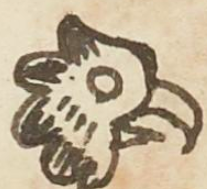cuauhtli (MH483r)
This element for eagle (cuauhtli) has been carved from the compound sign for the personal name, Cuauhtlahtoa. This is a profile view of just the head of an eagle, facing to the viewer's right. Its head is largely white with the wispy feathers along the crown being black. Its eye is just an open circle, and its beak is open.
Stephanie Wood
When cuauhtli was a name, it probably had a calendrical origin, i.e. drawing from the day in the calendar that the person was born. Eagle was a popular name. "They said the good days were Reed, Monkey, Crocodile, Eagle, House" (central Mexico, sixteenth century). See: Fr. Bernardino de Sahagún, Florentine Codex: General History of the Things of New Spain; Book 6 -- Rhetoric and Moral Philosophy, No. 14, Part 7, eds. and transl. Arthur J. O. Anderson and Charles E. Dibble (Santa Fe and Salt Lake City: School of American Research and the University of Utah, 1961), 129.
Stephanie Wood
1560
Xitlali Torres
eagles, águilas, nombres, names, calendarios, calendars

cuauhtli, eagle, https://nahuatl.wired-humanities.org/content/cuauhtli.
Matrícula de Huexotzinco, folio 483r, World Digital Library, https://www.loc.gov/resource/gdcwdl.wdl_15282/?sp=45&st=image.
This manuscript is hosted by the Library of Congress and the World Digital Library; used here with the Creative Commons, “Attribution-NonCommercial-ShareAlike 3.0 License” (CC-BY-NC-SAq 3.0).


